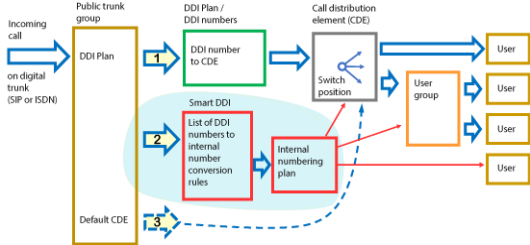Creating a DDI number
Lets you create a single DDI number or a DDI numbering range for ISDN or SIP connections and assign it a call distribution element or to a range of call distribution elements respectively. You can also create a SmartDDI number with a conversion rule who allows to route incoming calls directly to users, without the help of call distribution elements.
|
Parameter |
Explanation |
|
DDI plan |
Lets you select the DDI plan for which you want to create a new DDI number. |
|
Direct dialling number |
Enter here the DDI number you want to create. |
|
Call Distribution Element |
Select here the reference number of the call distribution element to be created together with the DDI number. The first available call distribution element is used as the default setting. |
Create a SmartDDI
SmartDDI allows a simple configuration to route incoming calls to the correct user, when DDI numbers and user numbers have a correlation. This is done with a simple conversion rule. In the conversion rule it is defined how the received DDI number shall be modified. With this modified number, the internal numbering plan is consulted. If the number matches an existing user, the call is routed directly to that destination.

The above picture shows the priority of the different call routing possibilities:
-
For an incoming call in first priority the existing DDI plan is consulted. If an entry matches the received DDI number, the call is routed to the assigned call distribution element.
-
If there is no match of the received DDI number in the DDI plan, then the SmartDDI conversion rules are consulted. If a conversion rule entry matches the received DDI number, it is converted and routed to the destination defined in the numbering plan. Allowed destinations are call numbers of users, PISN users, user groups or call distribution elements.
-
If no conversion rule entry matches the received DDI number or if the converted number does not match an allowed destination in the numbering plan, the call is routed to the defined call distribution element in the trunk group.
If the call is routed directly to a user or user group with SmartDDI, the call distribution element is not involved. This means that various features (e. g. announcement service or CLIP based routing) are not available in this case.
|
Parameter |
Explanation |
|
DDI plan |
Lets you select the DDI plan for which you want to create a SmartDDI conversion rule. |
|
SmartDDI number |
Enter here the SmartDDI number you want to create. Each number can consist of digits and placeholders. For rules and examples see chapters below. |
|
Matching internal number |
Enter the matching internal number. Each number can consist of digits and placeholders. For rules and examples see chapters below. |
|
Description |
Free text field for specifying the conversion rule. |
SmartDDI conversion rules
Each DDI plan can contain several SmartDDI conversion rules. An entry in the conversion rule table consists of a SmartDDI number and a matching internal number. Each number can consist of digits and the placeholder “x”.
For each number the following rules apply:
-
The number may consist of digits only
-
The numbers may consist of placeholders only
-
Placeholders must be always at the end of a number
-
The number of placeholders of a SmartDDI number and a matching internal number must be equal.
-
Entries with overlapping ranges with different number of placeholders are allowed.
-
In overlapping ranges, the entry with less placeholders (smaller range) has a higher priority.
-
For placeholders “x” or “X” are allowed.
Examples for entries in the conversion rule table
|
DDI plan |
SmartDDI number |
Matching internal number |
Remark |
|---|---|---|---|
|
1 |
4000 |
200 |
Entry with digits only. DDI 4000 is routed to internal number 200 |
|
1 |
xx |
xx |
Entry with placeholders only. 100 DDIs 00...99 are routed to the internal numbers 00...99. |
|
1 |
500x |
61x |
Entry with digits and placeholders. 10 DDIs in the range 5000...5009 are routed to the internal numbers 610...619. |
|
2 |
41326553xxx |
3xxx |
1000 DDIs in the range 41326553000...41326553999 are routed to the internal numbers 3000...3999. |
|
2 |
413265534xx |
8442xx |
This overlapping entry has higher priority than the entry above, because it contains less placeholders (smaller range). |
|
2 |
60xx |
30x |
Invalid entry. Number of placeholders must be equal. |
In USA/Canada the abbreviation DID (Direct Inward Dial) is used instead of DDI (Direct Dialling In)